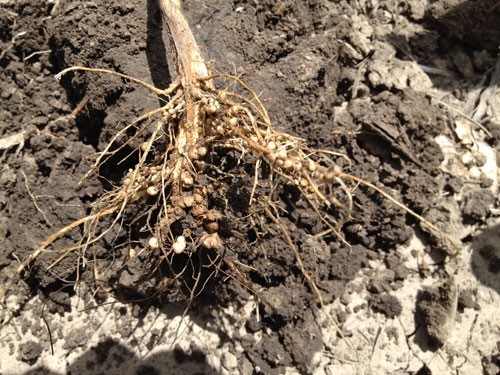 Figure 1. The large number and size of nodules is one sign of an adequate environment for nitrogen fixation of Bradyrhizobium species. (Photo by Nathan Mueller) (Source: UNL CropWatch article)
Figure 1. The large number and size of nodules is one sign of an adequate environment for nitrogen fixation of Bradyrhizobium species. (Photo by Nathan Mueller) (Source: UNL CropWatch article)
- Rhizobia bacteria form a symbiotic relationship with soybean plants, providing fixed nitrogen in exchange for carbon and shelter.
- Excess soil nitrogen, low iron, pH imbalances, compaction, extremes in soil moisture, and lack of a legume in rotation can negatively affect nodule formation.
- Around V2-V3, soybean fields should be checked for nodules that are actively fixing nitrogen.
- To address symptoms of nitrogen deficiency in soybeans (light green and stunted) rescue applications of dry nitrogen can be broadcast until R2.
Soybeans form a symbiotic (mutually beneficial) relationship with nitrogen-fixing bacteria that live in the soil (Figure 1). In this relationship, Rhizobia fix atmospheric nitrogen into a plant available form in exchange for plant-derived carbon and shelter. The bacteria persist in the soil and then form nodules on the soybean roots starting at V2 and increase until R5. The nodules that are actively fixing nitrogen are pink/orange on the inside while young nodules are white/grey. The pinkish color comes from the leghemoglobin transporting oxygen throughout the nodule, much like the role of hemoglobin in blood. Fields with adequate populations of Rhizobia that successfully complete nodulation can provide up to 280 lbs. of nitrogen per acre.
Without legumes in the field these bacteria will eventually die. Consequently, if soybeans or alfalfa have never been grown or not been grown in an area for several years, the use of a rhizobial seed inoculant is recommended. Even if a field has adequate rhizobia present, certain factors can negatively affect the nodulation process:
- Excess residual nitrogen in the soil negatively affects the formation of nodules. If more than 40 lbs N / A is available in the soil, nodulation rates decrease. This is because the amount of N for the plant is sufficient, and the plant does not engage in the symbiotic relationship with the Rhizobia. Basically, the plant “decides” it does not need to engage in the relationship and divert carbon to support the bacteria. Although this may seem beneficial, eventually this N will be utilized and the crop likely will become deficient later in the season. When nodulation levels are adequate, the nodules supply N to the plant throughout the season.
- Extreme wet or dry early season conditions. Aerobic organisms, including soybeans and Rhizobia, require oxygen to produce energy and survive. In water-saturated soils, oxygen is not available, and both roots and bacteria may die. Conversely, when conditions are dry, stomata in the leaves close and photosynthetic rates decrease, resulting in less carbon that can be shared with Rhizobia. Therefore, fields that experience early season floods or drought may have smaller nodules or fewer nodules, resulting in less nitrogen fixation and yields.
- Compacted soils. When soils are compacted, pore spaces are reduced. This results in a reduced volume for oxygen storage and exchange. In addition, roots are not able to develop well in compacted soils, which may limit their overall length and number, reducing opportunities to form nodules. Acquisition of other soil nutrients may be reduced, which may limit aboveground soybean growth and therefore, the amount of carbon that can be produced and shared with Rhizobia.
- Soil pH. Soil pH below 5.7 or above 7.3 negatively affects the survival of Rhizobia.
- Iron deficiency. Iron deficiencies affect the initial inoculation stage and result in low nodulation levels. This is because iron is an essential component of the molecule that Rhizobia use to fix nitrogen. To address iron deficiencies, ensure that the soil pH is between 5.7-7.3 and choose a cultivar that can handle IDC.
- The presence of soilborne pathogens and pests. Soilborne seedling pathogens that rot roots, such as Pythium, Phytophthora, Fusarium, Rhizoctonia, and Calonectria, plant pathogenic nematodes, grubs, wireworms, and seedcorn maggots can reduce root growth and stress the plant. This results in less root length for colonization by Rhizobia and carbon available to exchange with the bacteria
Around V2/3 fields should be assessed for nodulation. Use a shovel to carefully dig up ~10 soybeans plants from across the field. A zig zag sampling pattern is favored for this purpose. Place the plants into a bucket of water and rinse the remaining soil from the roots. A healthy plant should have 6 - 20 large, healthy nodules along the main tap roots and smaller ones along the auxiliary roots. Next, check for the color inside the nodule by cutting it open. Red or pink indicate active nitrogen fixation while white/grey suggest the nodules is still immature and should be checked in another week. If the nodules appear green, brown, or mushy , these nodules are dead.
If a field is showing symptoms of nitrogen deficiency (light green and stunted) because of poor nodulation, it is recommended to broadcast up to 50 lbs. of dry nitrogen over the field prior to R2. Liquid fertilizers applied at this rate can damage foliage. If a field needs a rescue application of nitrogen due to poor nodulation a rhizobia seed inoculant is recommended when next cultivating soybeans in that location.